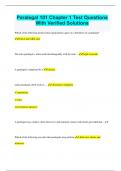Resume
samenvatting van boek everyday talk + hoorcollege slides aantekeningen
- Cours
- Établissement
- Book
hoofdstuk 1 tot en met 6 en 9 tot en met 11 van het boek everyday talk. ook de aantekeningen van de hoorcolleges van het vak cognitie en communicatie aan de uva zijn hierin verwerkt.
[Montrer plus]












